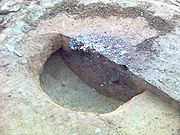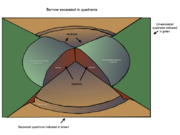
Archaeological section
Encyclopedia

Archaeology
Archaeology, or archeology , is the study of human society, primarily through the recovery and analysis of the material culture and environmental data that they have left behind, which includes artifacts, architecture, biofacts and cultural landscapes...
a section is a view in part of the archaeological sequence
Archaeological record
The archaeological record is the body of physical evidence about the past. It is one of the most basic concepts in archaeology, the academic discipline concerned with documenting and interpreting the archaeological record....
showing it in the vertical plane, as a cross section
Cross section (geometry)
In geometry, a cross-section is the intersection of a figure in 2-dimensional space with a line, or of a body in 3-dimensional space with a plane, etc...
, and thereby illustrating its profile and stratigraphy
Stratigraphy
Stratigraphy, a branch of geology, studies rock layers and layering . It is primarily used in the study of sedimentary and layered volcanic rocks....
. This may make it easier to view and interpret as it developed over time.

Sections
Half-sectioning is the usual method whereby one half of a featureFeature (archaeology)
Feature in archaeology and especially excavation has several different but allied meanings. A feature is a collection of one or more contexts representing some human non-portable activity that generally has a vertical characteristic to it in relation to site stratigraphy. Examples of features are...
is excavated and the remainder left in situ. Large linear features may be sectioned at intervals along their lengths. Sectioning has fallen out of favour in some schools of practice because detail is often missed in section that is important to the phasing
Archaeological phase
Archaeological phase and phasing refers to the logical reduction of contexts recorded during excavation to near contemporary archaeological horizons that represent a distinct "phase" of previous land use. These often but not always will be a representation of a former land surface or occupation...
of the site. Examples of detail that is revealed poorly "in section" include gravel or thin cobbled surfaces. The main problem with sections is the arbitrary location of their placement may "clip" or "just miss" contexts that reveal a different story form the one interpreted by the archaeologist. For instance thin liner features such as wheel ruts may be sectioned at an oblique angle giving the impression of a wider feature as the eye and brain tends to assume that features revealed in section have been cut at right angles to the orientation the feature was made. Numerous other false readings of sections are possible to the unwary, this is why excavation "in plan
Archaeological plan
An archaeological plan in an archaeological excavation, is a drawn record of features in the horizontal plane.- Overview :Archaeological plan can either take the form of...
" is now preferred. Sections are used in conjunction with two-dimensional excavation by plan
Archaeological plan
An archaeological plan in an archaeological excavation, is a drawn record of features in the horizontal plane.- Overview :Archaeological plan can either take the form of...
to determine the origin of archaeological remains. For recording purposes sections are normally drawn at a scale of 1:10 or 1:20 with their height related to the site benchmark
Benchmark (surveying)
The term bench mark, or benchmark, originates from the chiseled horizontal marks that surveyors made in stone structures, into which an angle-iron could be placed to form a "bench" for a leveling rod, thus ensuring that a leveling rod could be accurately repositioned in the same place in the future...
which in turn is related back to a level fixed at some agreed standard of sea level
Sea level
Mean sea level is a measure of the average height of the ocean's surface ; used as a standard in reckoning land elevation...
. Orientation should also be recorded. If the section is instructive a photographic record may also be made.
Stratigraphic control
Sections may also be employed in excavation in temporary fashion as a form of stratigraphic control so as to ascertain the relationshipRelationship (archaeology)
An archaeological relationship is the position in space and by implication, in time, of an object or context with respect to another. This is determined, not by linear measurement but by determining the sequence of their deposition - which arrived before the other...
between two or more contexts
Archaeological context
In archaeology, not only the context of a discovery is a significant fact, but the formation of the context is as well. An archaeological context is an event in time which has been preserved in the archaeological record. The cutting of a pit or ditch in the past is a context, whilst the material...
which may be better examined by the use of a section. Then once a relationship is established contexts can be removed from site in the reverse order they arrived in accordance with the stratigraphic excavation and the creation of a Harris matrix
Harris matrix
The Harris matrix is a tool used to depict the temporal succession of archaeological contexts and thus the sequence of deposition on a 'dry land' archaeological site. The matrix reflects the relative position and stratigraphic contacts of observable stratigraphic units, or contexts. The Matrix was...
for the sequence being investigated. It is up to the archaeologist on site to determine the best local on site strategy for excavating deposits, be it "in section" or "in plan". In this regard the modern archaeologist uses sectioning as a tool for understanding the site stratigraphically during excavation rather than as an end goal in recording it. These caveats aside sections remain a powerful tool for archaeological investigation. A revival of digging in section with machines has occurred in recent years by a proliferation of limited time constrained development led excavations.
Quarter sectioning

Tumulus
A tumulus is a mound of earth and stones raised over a grave or graves. Tumuli are also known as barrows, burial mounds, Hügelgrab or kurgans, and can be found throughout much of the world. A tumulus composed largely or entirely of stones is usually referred to as a cairn...
s, Deposits are excavated from four quarters of the feature, starting with two diagonally opposite quadrants and perhaps ending with the other two. The quadrants are slightly offset, so that the outer balk of one is continuous (in reverse) with the outer face of its opposite, going through the center of the feature. After the recording of the sections, the balks may be removed and the rest of the feature excavated. The advantage of quarter sectioning is it allows a look at two complete cross-sections while still allowing excavation in plan thus allowing a better interpretation of the stratigraphy of the site. The merits of this sectioning and balk creation are disputed.
See also
- Archaeological illustrationArchaeological illustrationArchaeological Illustration is a form of technical illustration that records material derived from an archaeological context graphically. - Overview :Archaeological Illustration encompasses a number of sub disciplines. These are:...
- Harris matrixHarris matrixThe Harris matrix is a tool used to depict the temporal succession of archaeological contexts and thus the sequence of deposition on a 'dry land' archaeological site. The matrix reflects the relative position and stratigraphic contacts of observable stratigraphic units, or contexts. The Matrix was...
- Archaeological contextArchaeological contextIn archaeology, not only the context of a discovery is a significant fact, but the formation of the context is as well. An archaeological context is an event in time which has been preserved in the archaeological record. The cutting of a pit or ditch in the past is a context, whilst the material...
- Archaeological planArchaeological planAn archaeological plan in an archaeological excavation, is a drawn record of features in the horizontal plane.- Overview :Archaeological plan can either take the form of...
- Archaeological associationArchaeological associationAssociation in archaeology has more than one meaning and is confusing to the layman. Archaeology has been critiqued as a soft science with a somewhat poor standardization of terms.-Finds and objects:...
- Relationship (archaeology)Relationship (archaeology)An archaeological relationship is the position in space and by implication, in time, of an object or context with respect to another. This is determined, not by linear measurement but by determining the sequence of their deposition - which arrived before the other...
- Cut (archaeology)Cut (archaeology)In Archaeology and archeological stratification a cut or truncation is a context that represents a moment in time when other archaeological deposits were removed for the creation of some feature such as a ditch or pit...
- Excavation (archaeology)
- Feature (archaeology)Feature (archaeology)Feature in archaeology and especially excavation has several different but allied meanings. A feature is a collection of one or more contexts representing some human non-portable activity that generally has a vertical characteristic to it in relation to site stratigraphy. Examples of features are...
- Single context recordingSingle context recordingSingle context recording was initially developed by Ed Harris and Patrick Ottaway in 1976, from a suggestion by Lawrence Keene. It was further developed by the Department of Urban Archaeology from where it was then exported, in the mid 1980s by Pete Clarke to the Scottish Urban Archaeological...
- Fill (archaeology)Fill (archaeology)In archaeology fills are contexts representing material that has accumulated or has been deposited into a cut feature such as ditch or pit of some kind...
- Spit (archaeology)Spit (archaeology)In the field of archaeology, a spit is a unit of archaeological excavation with an arbitrarily assigned measurement of depth and extent. It is a method of excavation employed without regard to the archaeological stratigraphy that may be identifiable at the archaeological site under investigation...

